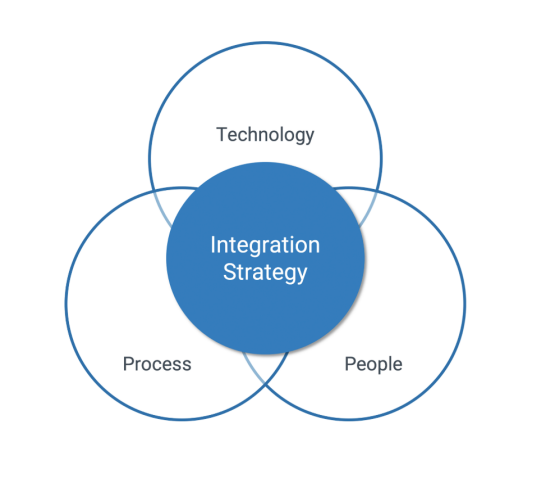
Introduction
Most conversations we have with growing companies start with one or more of the following statements:
- “Our business teams need to log into multiple systems to get the data they need”
- “We can’t scale with all the rekeying we are doing”
- “We have multiple manual processes”
- “We’re adding a lot of new technology and it’s taking too long to integrate it into our existing systems”
To grow your business, you must scale business operations. To scale operations takes people, process and technology. Your integration strategy sits at the cross-section of these three pillars. The typical goal for any integration strategy is to:
- Enable business teams with data in the systems they use
- Innovate and automate processes
- Free up resources to work on high-value projects and tasks
- Fully utilize your technologies
Three Steps to Get Started
Step 1: Determine what system will serve as your source of truth. For some organizations, it’s their ERP but for others, it’s their CRM. There is no right answer, but determining the system of record is a critical starting point for your integration strategy. The system you choose is your data management system and the anchor for the bulk of your integrations. Without clearly determining your system of record, you will find it impossible to trust your data which will make it difficult to decide what data to move to what systems and when.
Step 2: Map your applications. A recent survey by IDC of mid-sized companies showed that 65% use 20-99 different cloud applications to run their business. Of those companies, the best-run ones were actively working to eliminate data silos while the laggards were barely making a dent in the problem.
Step 3: Identify the apps that need to be integrated, and remove the apps that don’t add enough value. Try to simplify your application landscape as much as possible so your teams are not managing business applications and building integrations that bring no real value.
Tip: Be harsh.
Start Small but Don’t Think Small
Integration requirements tend to be fluid in high growth companies. Your integration strategy needs to be flexible enough to accommodate changes without forcing a massive IT project or forcing you to rewire your integrations when you add new technologies. A common mistake is to think you just need to build a couple of integrations and all will be good. That might be the case initially but it rarely remains that way.
As you think about your integration needs, look beyond immediate requirements to what might be needed in 3-6-12 months’ time. Giving equal weight to current and future requirements plus a healthy nod to the unknown reduces the risk that you’ll need to rework your strategy and technology decisions in a few months.
As the IDC chart below shows, the greatest difference between best-run companies and laggards is the ability for IT to deliver an integrated application infrastructure that supports business agility and innovation.
Free Advice: Don’t try to boil the ocean and integrate everything all at once. It will take too long to execute and see the value. Instead, create a staggered execution plan so you are consistently delivering value and incremental improvements. In development terms, think Agile not Waterfall.
If budget is a concern, most integration vendors provide tiered pricing so you can start small and expand as needed. Once you’ve nailed implementation of your mission-critical integrations and realize value, you can usually get the funding needed to expand to secondary systems and processes.
Contact Us for more information on how to create an integration strategy to power growth with Celigo for your Business.
Copyright © 2024 - Custom Software Solutions, Inc.







